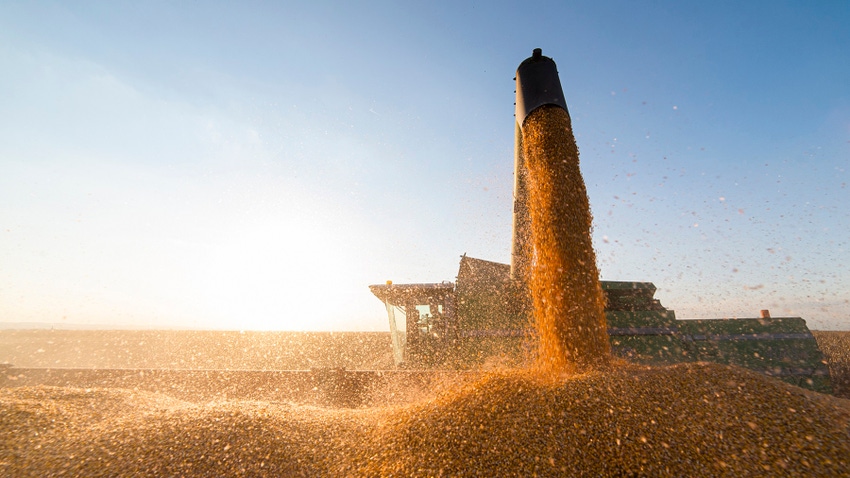
Despite much pre-report trade anticipation for USDA to potentially make cuts to Brazilian corn and soybean production in today’s WASDE report, USDA instead left 2023/24 corn and soybean production estimates for the South American country unchanged.
USDA also trimmed 2023/24 ending corn stock volumes for U.S. supplies after adding more consumption to feed and residual as well as ethanol volumes. However, the markets had likely already priced in those expectations prior to the report’s release, leading corn prices to drift slightly lower in the report’s aftermath before returning to fractional gains.
Soybean prices continued to trade at a loss following the report’s release, though slightly higher European Union import volumes helped to trim the losses. Wheat prices fell around a penny lower as more wheat from Russia, Ukraine and Australia floods the market and major buyers from the Middle East show signs of reducing import volumes.
“There weren’t too many surprises in today’s WASDE report, which is not unusual for the April report series,” notes Farm Futures grain market analyst Jacqueline Holland. “Ending stocks were adjusted to align with the recent data provided by the Quarterly Grain Stocks report published a couple weeks ago, so those changes did not sway market prices significantly.”
Corn
For corn, USDA noted increased use for ethanol and feed and residual use, leading to smaller ending stocks. Corn used for ethanol moved 25 million bushels higher, with feed and residual use also moving 25 million bushels higher. Because of that, ending stocks trended 50 million bushels lower to 2.1 billion bushels. Analysts were expecting an even bigger cut of 70 million bushels, however. The season-average farm price dropped 5 cents to $4.70 per bushel.
In South America, Argentina’s production potential fell from 2.205 billion bushels in March down to 2.165 billion bushels. That was lower than the average trade guess of 2.190 billion bushels. In Brazil, production held steady at 4.482 billion bushels, while analysts were expecting USDA to reduce that number to 4.793 billion bushels.
“Of all the data updated by USDA, markets were most eager for potential USDA revisions to Brazilian corn and soybean production for the 2023/24 marketing year,” Holland says. “And while there were some hopes that a corn disease reported in Brazil’s safrinha corn fields would cause some yield downgrades after Brazilian crop agency Conab published smaller corn and soybean production estimates earlier this morning, USDA opted for a more conservative approach.”
Global corn production for 2023/24 fell to 12.531 billion bushels versus March’s volume of 12.584 billion bushels. Lower production potential in South Africa, Argentina, Mexico and Moldova were partially offset by increases in the European Union and the Philippines.
Soybeans
USDA’s latest notes for soybeans noted “lower imports, residual and exports, and higher ending stocks.” Ending stocks moved 25 million bushels higher to 340 million. Analysts were only expecting a 2-million-bushel increase, with an average trade guess of 317 million bushels. The season-average farm price fell 10 cents to $12.55 per bushel.
“The Quarterly Grain Stocks report had earlier indicated that December 2023 - March 2024 soybean consumption in the U.S. was lagging behind year-ago levels, due in no small part to slower Chinese buying paces and a smaller U.S. crop harvested last fall," Holland says. “As a result, USDA cut soybean usage volumes for exports, seed and residual categories in Thursday’s WASDE report. Crush demand remained unchanged, though this will be the item I will be watching most closely going forward. “
Several new crush plants are forecasted to come online this fall, Holland adds. While that may not occur in enough time to give old crop soybean prices a major summer boost, it could keep enough life in the cash markets to offer farmers profitable options throughout the summer, she points out.
In South America, Argentina’s production held steady at 1.837 billion bushels, with analysts expecting USDA to move slightly higher to 1.855 billion bushels. In Brazil, production potential also held steady at 5.695 billion bushels. Analysts were expecting to see modest reductions after offering an average trade guess of 5.573 billion bushels.
“Soybean harvest is largely completed in Brazil,” Holland says. “Widespread and plentiful rains are in the forecast for Brazil over the next ten days, arriving right before key pollination periods for safrinha corn fields. That weather outlook bodes favorably for Brazilian corn yields and production for the 2023/24 growing season and could keep a ceiling on any upward price movement we see in the corn market as planting ramps up in the U.S. in the coming weeks.”
Globally, soybean production was very close to March’s volume of 4.198 billion bushels, easing slightly lower to 4.196 billion bushels. Analysts were expecting to see that number drop to 4.178 billion bushels.
Wheat
USDA’s outlook for wheat noted “lower supplies, reduced domestic use, unchanged exports and higher ending stocks.” Projected ending stocks for 2023/24 moved 25 million bushels higher to 689 million bushels, which is a year-over-year increase of 22%. The season-average farm price faded 5 cents lower to $7.10 per bushel.
World stocks decreased from 9.509 billion bushels in March down to 9.490 billion bushels in April. Analysts were expecting that number to increase to 9.521 billion bushels, in contrast.
Read more about:
WASDEAbout the Author(s)
You May Also Like








